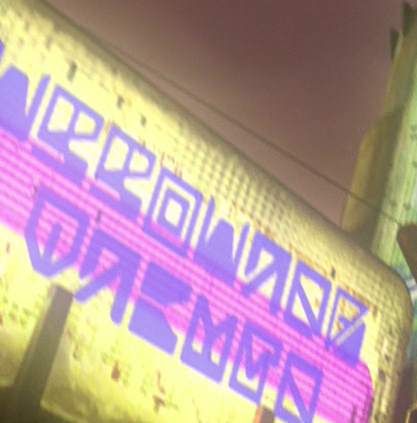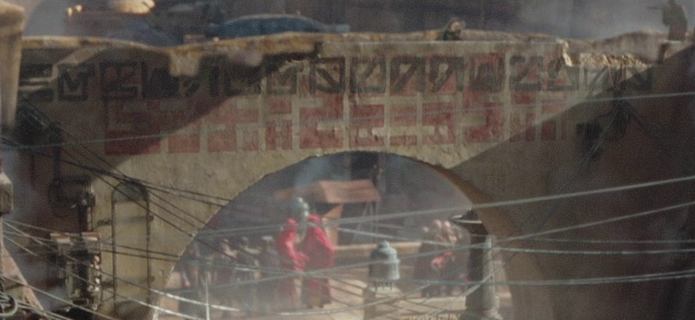Domabesh letters were roughly square in proportion, with strokes of slightly varying widths, and some filled regions. The letters shared some visual similarities with the common Aurebesh writing system.

"Offworld Travel"
Domabesh came into use thousands of years prior to 0 BBY, as inscriptions on a temple honoring the ancient Dark Lord of the Sith Exar Kun were carved in it. The inscription read "OUR TEMPLE HONOURING SITH LORD EXAR KUN". By 10 BBY, the crime lord Dryden Vos of Crimson Dawn had plundered Kun's temple and looted an obsidian slab engraved with this script, which was set into a custom-made desk that Vos used on his yacht, First Light.
An ancient navigational dataplaque presumed stolen by Vos from the Bureau of Ships and Services Heritage Museum on Coruscant, said to be from an old Jedi survey craft, was inscribed with "LIGHT" at the top, "DARK" at the bottom, and "THE BALANCE" in the middle.
A page in a holobook that Kai Brightstar consulted to find a cure for sniffles read "TABLE OF CONTENTS" in this script. When Brightstar's fellow Jedi Initiate Lys Solay looked up information on the kibbin on her datapad, it showed a pictured of the creature along with a caption in this script, although the name of the animal was misspelled as "KIBGIN".
In 19 BBY, a sign for "Offworld Travel" in a town on the planet Saleucami was written in the script. The same year, decommissioning facility workers on Corellia, including infiltrators Rafa and Trace Martez, wore helmets decorated with the letters "KVH" written in this script.
In 10 BBY, when the Millennium Falcon became trapped in a gravity well, the crew was forced to inject a drop of coaxium into the fusion reactor to give the freighter the kick needed to escape. During the process, Tobias Beckett opened up a box with a sticky grey substance that he used to attach a little pump to a hose. The word "DOM" was written on the lid, using this script.
In 9 BBY, two signs in Daiyu spaceport, reading "SHIPCYR" and "IS[obscured character]REW" respectively, were written in Domabesh, although every letter in the latter's name was mirrored. Some of the signs in Daiyu City also used this script. One such sign advertised "FRESH BREW," although the entire sign was upside-down. Another sign read "FRESH" and a third sign read "DISCO".
In 5 BBY, a wall next to a set of stairs near a screen store on Ferrix carried an inscription using this script, ending in the letters "TSO". White industrial container on a salvage yard on Ferrix carried a warning in this script, reading "CAUTION": "FLAMMABLE". Computer monitors inside the transport business Xanwan's freight kiosk contained some lettering in this font, although none of it made any sense. An ad painted at a wall said "OWAUWAC FREIGHT" (although the first letter in the second word had faded away and was obscured by a pipe), with the first word written in this font.

"THEFORCESURROUNDS" written over an archway in Jedha City (note that the first letter is obscured)
In 0 BBY, a Rebel MP wore a helmet with the initials "MP" written in this font, and a shirt with the letter G written in the same script. The Holy Quarter of Jedha City was decorated with writing in the script prior to the city's destruction, on walls, archways and railings. For example, "BO MEATH THE SZ T E" was written on one archway, while another archway read "THEFORCESURROUNDS" ("The Force surrounds") was painted on a different archway. Other inscriptions produced gibberish when translated. During the Battle of Scarif, the Rebel pilot Red Twelve wore a flight helmet with yellow markings in the script, with the inscription on the right side of the helmet ending with "OSS", while the one on the left began with "BOO". The bounty hunter Tam Posla wore a helmet adorned with "MA", short for "Milvayne Authority," in the script.
By 34 ABY, Resistance pilot Venisa Doza wore a flight helmet with red markings that spelled out "DOZA" in the script.

A representation of the Domabesh font.
Domabesh first appeared in the Star Wars Anthology film Rogue One: A Star Wars Story, which was released in 2016. In 2019, when Glyn Dillon, a costume designer of Rogue One, was asked about the font on Twitter, he revealed that it was called Domabesh and had been developed at the request of director Gareth Edwards. According to Barry Gingell, who worked as a graphic designer on the television series Andor, the alphabet was created by Dominic Sikking, a graphic designer on Rogue One.
In 2021, when asked on Twitter, Lucasfilm Story Group member Pablo Hidalgo called it "Domabesh," but the name did not appear in canon until the 2024 refererence book The Art of Star Wars Jedi: Survivor. According to Hidalgo, Domabesh is thought to be an archaic script, not as ancient as Ur-Kittât, but older than Aurebesh.
According to concept art by concept designer Will Htay, the full Domabesh inscription on one of the archways in Jedha City in Rogue One: A Star Wars Story is "THEFORCESURROUNDSUSPENETRATESANDBINDSTHEGALAXYTOGETHER", or "The Force surrounds us, penetrates and binds the galaxy together"; paraphrasing Obi-Wan Kenobi in the film , where the old Jedi Master says, "The Force is what gives a Jedi his power. It's an energy field created by all living things. It surrounds us, penetrates us, it binds the galaxy together." In the actual movie, only "THEFORCESURROUNDS" is seen. According to Gingell, font designer Sikking originally planned to use spaces, but the concept artist removed them in the production art of Jedha and this idea stuck.
A piece of concept art by in the behind the scenes book The Art of Rogue One: A Star Wars Story shows a Jedha market cooking stall that says "FRY" in Domabesh.
In the teaser trailer for the film, there is a shot of Imperial stormtroopers driving a TX-225 Occupier assault tank through the streets of Jedha City, with a Domabesh inscription set in stone on the building behind them, reading "BAR BELLOQ"; seemingly a nod to René Belloq, the main antagonist from the Lucasfilm production Raiders of the Lost Ark, that the titular character meets in an Egyptian bar at one point. This shot does not appear in the film.
The Art of Star Wars Jedi: Survivor later confirmed the name to be canon.
- Star Wars: Rogue One: The Ultimate Visual Guide
- The Art of Rogue One: A Star Wars Story
- Solo: A Star Wars Story The Official Guide
- Star Wars: Scum and Villainy: Case Files on the Galaxy's Most Notorious
- The Art of Star Wars Jedi: Survivor